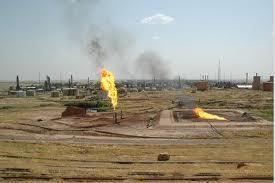Offshore/onshore Onshore Region Kurdistan | Discovery 1927 Start of production 1934 | |
 | ||
Recoverable oil 10,000 million barrels (~1.7×10^ t) | ||
Kirkuk Field is an oilfield near Kirkuk, Iraq. It was discovered by the Turkish Petroleum Company at Baba Gurgur ("St. Blaze" in Kurdish) in 1927. The oilfield was brought into production by the Iraq Petroleum Company (IPC) in 1934 when 12-inch pipelines from Kirkuk to Haifa and Tripoli (Lebanon) were completed. It has ever since remained the most important part of northern Iraqi oil production with over 10 billion barrels (1.6 billion cubic metres) of proven remaining oil reserves in 1998. After about seven decades of operation, Kirkuk still produces up to 1 million barrels per day (160,000 cubic metres per day), almost half of all Iraqi oil exports. Oil from the Kirkuk oilfield is now exported through the Kirkuk-Ceyhan Oil Pipeline, which runs to the Turkish port of Ceyhan on the Mediterranean Sea.
Some analysts believe that poor reservoir-management practices during the Saddam Hussein years may have seriously, and even permanently, damaged Kirkuk's oilfield. One example showed an estimated 1.5 billion barrels (240 million cubic metres) of excess fuel oil being reinjected. Other problems include refinery residue and gas-stripped oil. Fuel oil reinjection has increased oil viscosity at Kirkuk making it more difficult and expensive to get the oil out of the ground.
On 11 July 2014 Kurdistan Regional Government forces seized control of the Kirkuk oilfield, together with the Bai Hassan field, prompting a condemnation from Baghdad and a threat of "dire consequences," if the oilfields were not returned to Iraq's control.
